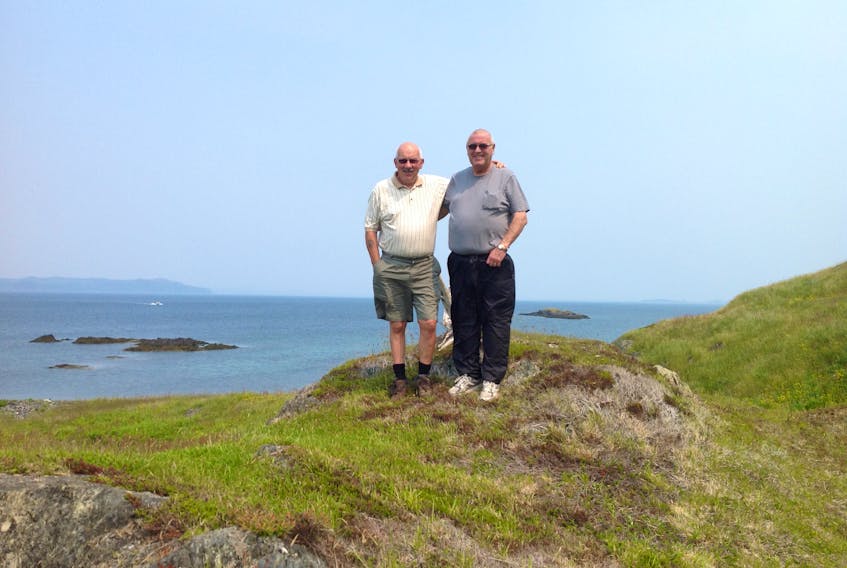Ray Hann’s family was the last to leave Merasheen in Placentia Bay as part of the resettlement programs of the 1950s through to the 1970s.
At age 18, Hann was responsible for going to the powerhouse in the early morning of Oct. 9, 1968 and shutting off the power to the community. His were also the last boots on the wharf as he untied the mooring lines and jumped aboard the MV Bertha Joyce to join the rest of his family — his nine siblings and parents — as they sailed to Marystown.
Their two-storey, four-bedroom house, outbuildings, sheds and wharf lay silent among the others on the windswept, beautiful island.
Hann’s father, Patrick James Hann, had nailed a sign to the front door of their unlocked house: “Use but please do not abuse.” The family intended to return in the spring to prepare to move the house across the bay.
As they were making their way out the harbour that day, Hann, being a young man, felt some excitement of what might lie ahead. His parents, however, cried — it was the first time he and his siblings had ever seen their father shed tears.
In the days to come, Hann would reflect on the impact resettlement had on his parents and grandparents and others of his community. It would hit home deeply, and bitterly, when they returned to Merasheen about six months later and found their house, and the belongings left behind, ransacked. The outbuildings were also broken into and fishing gear stolen.
“When we left there we thought that we were going to be able to go back and move our house the following year,” Hann said. “A beautiful home, but when we went back six or seven months later and it was gutted, that’s when the wound became really raw for me. It was absolutely terrible.”
The year 2018 will mark 50 years since the lights went out in Merasheen for the last time as a permanent settlement. A major homecoming celebration is planned for the last weekend in July to mark the anniversary.
In the lead-up to the event, Hann has set up a webpage where he has written the story of Merasheen, supported by documents his father had kept.
Patrick James Hann had led the fight to try to keep Merasheen intact as resettlement loomed all around the bay. As chairman of the community council, he had written letters to government officials, to the church and to whomever he felt could help.
“My dad passed away in 1978. He had saved all of those documents and they came into my possession,” Hann said. “I looked at them and sat on them for a long time. It was a story I wanted to tell, but it’s a bit painful to tell. I felt my father saved the documents for a reason and I wanted to tell the story in his memory. It was an extremely difficult time for him, and saving the documents … they were sort of whispering to me that maybe I should tell the story. That’s what motivated me to do it.”
Merasheen, located on the southwestern tip of Merasheen Island — with a population of about 290 people in 1961 — had been one of the more prosperous communities in the bay. At one point it was considered to be a centre that residents of other communities could relocate to. It had a naturally protected, ice-free harbour, a salt fish/fresh fish plant, and a diesel-powered generator providing electricity.
The community was close-knit, and when it looked as if resettlement was inevitable, many residents requested that they be moved as a group to another location. They didn’t like how resettlement was shaping up.
In one letter to government officials, Patrick James Hann wrote that the people of the community were not totally opposed to relocation as long as it didn’t set them back.
“Strictly speaking we are not opposed to centralization as such, and would like to improve our way of living, our means of support and our environment in general, but under the present centralization system such improvements are impossible,” he stated.
“Merasheen is, and always was, one place in Placentia Bay where a man who is willing to work can earn a comfortable living for his family and live quite independently. We may not have all the necessities of life, but at least we have what it takes to live happy and contented lives.”
In another letter in 1967, he expressed concern that “the majority of the people of Merasheen would prefer to stay at home and earn an honest living, rather than accept a small government grant at the expense of their lifetime savings and wind up worse off than before.”
Gradually, people were leaving Merasheen under the resettlement program, thus making it more difficult for remaining residents to stay. Many resettled in Freshwater, Jerseyside, Placentia, Point Verde and St. John’s.
Hann’s family decided to go to Marystown.
Hann’s mother, Mary, as was a tradition with many families, made notes on the family bible to mark significant milestones or special occasions.
Just after arriving at their new home in Marystown, she wrote, “We left dear old Merasheen on Oct. 9, 1968. Arrived in Marystown around 1:30. I was heartsick.”
Hann, who along with his wife now spends their summers at Merasheen, has studied a number of government reports surrounding resettlement and, combined with the papers his father had saved, said it reveals a “scheme” that ultimately forced more than 25,000 people from their homes during the resettlement program.
“However noble in intent and objective, the execution of the (resettlement) program by both levels of government was criminal,” Hann said. “Every householder forced to relocate under the scheme should have been made whole. That they were not is the greatest crime of resettlement.”
He said if the government had heeded the warnings in the 1957 report of the South Coast Commission, things may have been less painful and more respectful toward families.
The report states: “The commission feels that it is unrealistic to suggest a movement of people of such magnitude. Some re-location is desirable and essential, but steps must be taken to improve conditions in the fishery so that many people will be able to remain in that occupation.
“A positive programme of providing employment must be combined with a policy of paying the costs of relocation. It should be emphasized that employment opportunities must be available, and must precede the granting of financial assistance if a relocation policy is to be successful.”
Hann said further reports were written that better suited the government’s agenda as they pushed for the federal government to help fund resettlement. He said letters in his father’s collection also show the Roman Catholic Church was part of the collusion.
On June 28, 1967, he noted, the local priest informed residents that he would be leaving Merasheen to become assistant parish priest at Placentia on the orders of Archbishop Skinner in St. John’s.
Residents were shocked and upset, and Patrick James Hann wrote to the archbishop and asked him to reconsider the decision.
Skinner refused and wrote back, saying, “as archbishop I am faced with responsibility for my priests and people. Therefore, I have to consider Father Power’s situation, his health and well-being.”
The local priest, however, had written to Skinner saying that if the people wished him to stay, he’d be happy to oblige. He wrote: “I am enjoying the best of health, take delight in doing my best to administer the sacraments to the people of (Merasheen and St. Kyran’s parishes).”
Skinner also wrote in his letter: “A further consideration is the whole movement of centralization and the major work of providing the best possible educational opportunities for our children.”
Hann said Skinner’s decision was the final nail in the coffin for Merasheen. He said the letter indicates Skinner’s support for the relocation scheme and an abandonment of the people of Merasheen.
“A shepherd never abandons his flock,” Hann said. “Their spiritual needs had not even been considered and they were completely cut adrift from the church.”
Hann says the aim of resettlement was to relocate small communities to larger centres where people would find better job opportunities, public facilities and better services. But, he said, friends and families were scattered, and for a pittance people left behind their homes and fishing premises that had taken a lifetime to build.
He said as opportunities for work in growth centres failed to pan out, many of the men returned to Merasheen in the summers to fish in order to support their families.
“The pain, sacrifice and price paid by some families are bitter and painful memories,” Hann said. “At the very least they should have been able to move into a house the equivalent of what they had, and very few people in Placentia Bay could do that.”
He says the day after his family left Merasheen, his father sent the captain of the coastal boat, the H.V. Petite Forte, a telegram informing him the boat no longer needed to stop at Merasheen.
“Advising that the last survivors of Merasheen have been forced to capitulate. Future callings unnecessary,” Patrick James Hann’s telegram message read. “If Messers Sheen and O’meare had kept going their separate ways centuries ago on that densely wooded island in Placentia Bay and never met, the crime of leaving Merasheen deserted today might never have perpetuated. However, some of today’s fanatics have contributed greatly towards the crime.”









